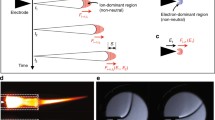Abstract
Analytical expressions are presented for the drag force acting on an evaporating or nonevaporating particle immersed in a plasma flow for the extreme case of free-molecule flow regime and thin plasma .sheath. It is shown that the drag force on a spherical particle is proportional to the square of the particle radius and to the relative velocity between the particle and the bulk plasma at low speed ratios. The existence of a relative velocity between the particle and the plasma results in a nonuniform heat flux distribution with its rnaximum value at the frontal stagnation point of tire sphere. This nonuniform distribution of the local heat fux density causes a nonuniforrn distribution of the local evaporated-mass flux and vapor reaction force around the surface of an evaporating particle, and thus induces an additional force on the particle. Consequently, the drag force acting on art evaporating particle is always greater than that on a nonevaporating one. This additional drag force due to particle evaporation is more significant for nonmetallic particles and for particle materials with lower latent heat of evaporation and lower vapor molecular mass. It increases with increasing plasma temperature and with decreasing gas pressure at the high plasma temperatures associated with appreciable gas ionization. The drag ratio increases with increasing electron/heavy-particle temperature ratio at high electron temperatures for a two-temperature plasma.
Similar content being viewed by others
References
Xi Chen,Heat Transfer and Fluid Flow under Thermal Plasma Conditions, Science Press, Beijing (1993). (In Chinese).
J. A. Lewis and W. H. Gauwin,AIChE J. 19, 982–990 (1973).
Y. C. Lee, K. C. Hsu, and E. Pfender,Proc. 5th Int. Symp. Plasma Chem., Vol. 2 (1981), pp. 795–803.
V. V. Kabanov and V. S. Klublikin,Inzh. Fiz. Zh. 48, 396 402 (1985). (In Russian).
M. K. Asanaliev, Zh. Zh. Zeenbaev, V. M. Leliovkin, K. K. Mekesheva, and R. M. Urusov,Plasma Chem. Plasma Process.11, 269–286 (1991).
Xi Chen, Jian-yong Qui, and Jun Yang,Plasma Chem. Plasma Process.11. 151–168 (1991).
Xi Chen,Chin. Phys. Lett. 10 (Supplement), 97–104 (1993).
Xi Chen and E. Pfender,Plasma Chem. Plasma Process.3, 351–366 (1983).
Xi Chen and Xiao-ming Chen,Plasma Chem. Plasma Process.9, 387–406 (1989).
A. G. Gnedovets and A. A. Uglov,Plasma Chem. Plasma Process.11, 251–267 (1991).
R. Westhoff, G. Trapaga, and J. Szekely,Metall. Trams. B 23, 683–693 (1992).
Xi Own and E. Pfender.Plasma Chem. Plasma Process.2, 185–212 (1982).
Xi Chen and Ping He,Plasma Chem. Plasma Process.6, 313–333 (1986).
Xi Chen,Pure Appl. Chem. 60, 651–662 (1988).
Xi Chen and Xin Tao,Plasma Chem. Plasma Process.14, 163–192 (1994).
E. Leveroni and E. Pfender,Int. J. Heat Mass Transfer 33, 1497–1509 (1990).
Author information
Authors and Affiliations
Rights and permissions
About this article
Cite this article
Chen, X., Su, B. & Yu, L. Drag force acting on an evaporating particle immersed in a rarefied plasma flow. Plasma Chem Plasma Process 15, 1–23 (1995). https://doi.org/10.1007/BF01596679
Received:
Revised:
Issue Date:
DOI: https://doi.org/10.1007/BF01596679



